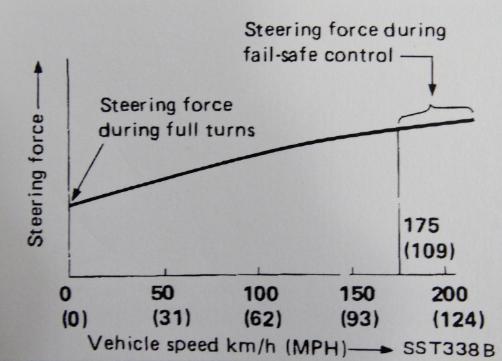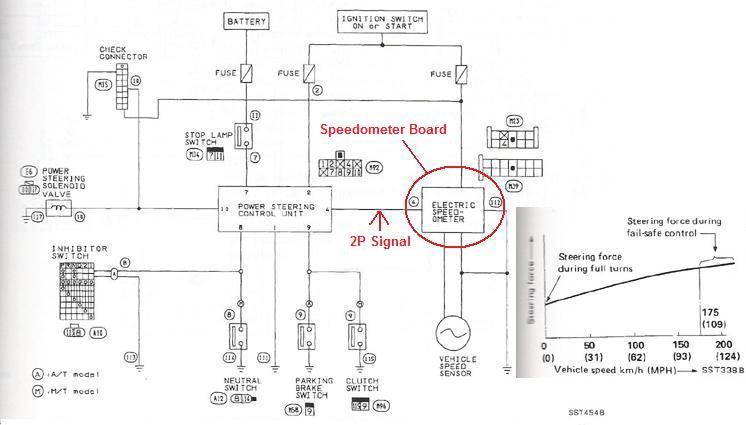| A defective speedometer has become one of the most common causes of a power steering problem. Specifically, it can cause a hard steering problem. The PS control module receives the 2P signal from the speedometer board. The speedometer board creates the 2P signal from the speed sensor signal. It tells the PS control module how to regulate the PS rack solenoid. The PS rack solenoid allows a specific amount of pressure in the PS system in accordance with how fast the vehicle is moving. The solenoid is a variable release valve solenoid that is controlled by a wave forming signal via the PS control module. With a loss of the 2P signal at the PS control module, the module goes into safe mode. In safe mode the module outputs a signal to the PS rack solenoid at an equivalent pressure needed at a vehicle speed of 109MPH. That amount of pressure at any typical driving speed or even stationary makes it extremely difficult to turn the steering wheel. It’s referred to as a hard steering problem. The PS pressure switch signal is sent to the ECU via pin 34. When the ECU sees it, it uses the speed signal to calculate how much it needs to raise or lower RPMs which it does without interaction from your foot to control proper pressure to the PS system. At the same time, it uses that calculation to determine if it needs to cut the AC via pin 9 from the ECU.

This PS solenoid is not just an on off solenoid like typical solenoids. It is controlled by a wave forming circuit which controls how much it is opened or closed. The PS control unit uses other inputs in combination with the 2P speed signal as a fail safe system. If any one of the inputs are incorrect, the solenoid will be set to a fail safe condition. So it is possible that things other than a loss of the 2P signal can cause a hard steering problem.

Modules that utilize the 2P signal: - ECU
- HICAS control unit
- Power steering control unit
- Automatic Transmission control unit The speed sensor signal goes to the gauge cluster via pin 17 wo/airbag or pin 15 w/airbag. Then, the 2P signal is sent from the speedometer board to the ECU pin 53, the HICAS control unit pin 6, the power steering control unit pin 4 and the A/T control unit pin 27. Electrical issues that can cause PS problems:
1. Check your power steering oil pressure switch. The FSM tells you to check the power steering oil pressure switch for 2-3 ohms of resistance between it's terminals when it is disconnected. What it doesn't tell you is that the switch is a normally open switch and that in order to see a resistance of 2-3 ohms it has to be closed. You must check the switch while the power steering system is together and while turning the steering wheel with the car running. The purpose of the switch is to tell the ECU when the power steering pressure has reached a certain point of pressure. When this happens, the switch closes. The ECU detects that the switch is closed and raises the engine RPMs to allow the power steering pump to raise the PS oil pressure.
2. Check the power steering solenoid (1990 FSM page ST-37, page ST-88). The power steering solenoid operation is dependant on vehicle speeds. The power steering solenoid reduces the amount of pressure that reaches the steering gear at higher road speeds. If the signal is lost or the solenoid is not working properly, you may see a loss of road feel and/or increased steering sensitivity at highway speeds.
3. Check the steering wheel angle sensor (1990 FSM page and 1990 FSM page ST-57). If the sensor is bad or the sensor is loose it can cause erroneous signals to the PS system which will effect it's operation. These signals are sent to the HICAS/Power steering module.
4. Check the position of the steering wheel and the steering wheel neutral position switch (1990 FSM page ST-58). The steering wheel neutral position switch must be centered when driving in a straight line. If not, it will send erroneous signals to the PS system while driving straight or in turns which will effect it's operation. These signals are sent to the HICAS/Power steering module.
Effects of loss of 2P signal: 1. As already mentioned, loss of the 2P signal can cause a hard steering problem where it takes a greater amount of physical force to turn the steering wheel. 2. A loss of 2P signal can also cause a PS fluid problem where you see PS fluid coming out of the reservoir. When the PS module is in fail safe mode caused by loss of 2P signal, the PS solenoid will not operate properly which can cause an unstable pressure and flow of fluid in the PS system. This can cause a rise and overflow of fluid in the PS reservoir.
How to determine if there is a loss of 2P signal:
If the 2P signal is lost for 10 or more seconds, a hard steering problem will occur. You can eliminate the possibility of a loss of 2P signal by using consult software or a piece of hardware such as a TechTom MDM-100 to monitor the speed signal at the ECU. The speed signal must be monitored while driving. You can simulate driving by placing the rear of the vehicle on jack stands so that the tires clear the floor.
How the speedometer board handles the speed sensor signal:
The speedometer board circuitry performs three functions. 1. It controls the gauge motor to display indicated speed via the gauge needle.
2. It controls the odometer motor to show mileage.
3. It sends a modified speed signal (2P) to the ECU and other modules in the vehicle to control speed related functions. With a bad speedometer board, any one, or a combination of any of the three, or all three of the functions can stop working. As an example, the odometer can stop working while the other two functions still work. Or the odometer and gauge needle work but you have a hard steering problem due to lack of speed signal at the ECU.
The speedometer signal and 2P signal explained:
The speed sensor is a wave forming circuit that produces an output signal in hertz via two wires, ground and signal out. A speed sensor signal of 273~Hz = 60 mph. This gives you a 2P signal of 34~Hz. On some but not all speedometer boards, you may see "60MPH=1024rpm" written on the face. This can only be seen inside the gauge cluster. 60MPH is displayed on the gauge when the speed sensor RPMs is 1024. The speed sensor generates 16 pulses per 1 revolution of the speed sensor. 1 RPM = 0.0166666666666667 x 16 = 0.2666666666666672 Hz 60 MPH = 0.2666666666666672 x 1024 = 273.0666666666672128 Hz 60 MPH = 273.0666666666672128 Hz (Input drive signal to equal 60 MPH) 1 MPH = 273.0666666666672128 / 60 = 4.5511111111111202133333333333333 Hz
2P output signal to ECU at 60 MPH:
The 2P output signal to the ECU is the speed sensor signal divided by 8 and converted to a DC square wave. If using a scope to measure it you won't see it if the gauge is not connected to the ECU. You'll need to use a pull up resistor. 2P = 273.0666666666672128 Hz / 8 = 34.1333333333334016 Hz @ 60mph.
Steering rack solenoid notes:
Some people have said they have no hard steering problem when the gauge cluster is removed, the PS module is removed or the wire to the steering rack solenoid is broken. The reason is, when there is a loss of signal to the PS solenoid, the solenoid orifice opening can stay in a position that allows the steering to feel normal. You may feel the hard steering come and go. This is because when there is no electrical action on the solenoid, the orifice opening can shift around as the fluid passes through it during pressure changes in the system such as making turns.
Cautions:
Trying to test the steering rack solenoid or trying to bypass control to the solenoid by applying DC voltage to the solenoid input cannot be done. This is because the signal to the solenoid is a signal of varying hertz and not a changing value of DC voltage. Applying direct DC voltage to the solenoid can possibly damage it.
 www.mytwinturbo.com Nissan Data Voice - The first Nissan diagnostic software with a voice!
 Nissan Data Voice on YouTube Download my Nissan 300ZX Vin/Model Lookup. |

